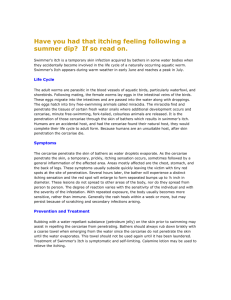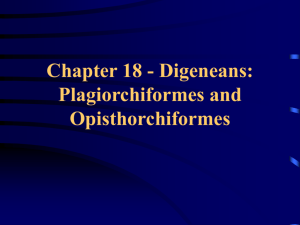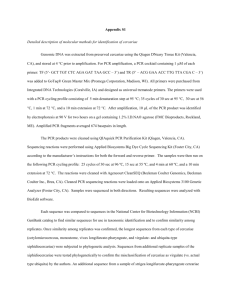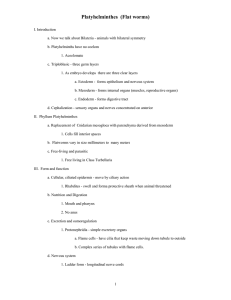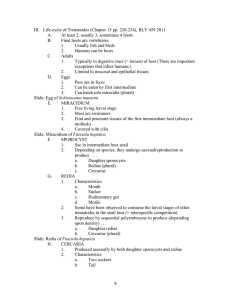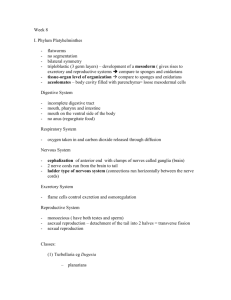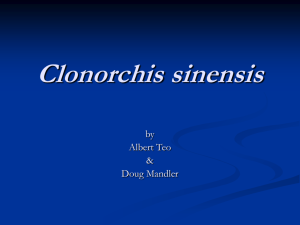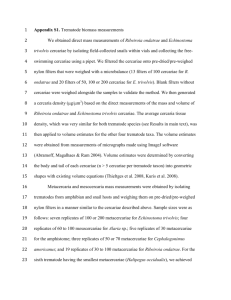The migration of Cotylurus erraticus cercariae (Trematoda: Strigeidae) in rainbow... gairdneri) and their effects on the host
advertisement
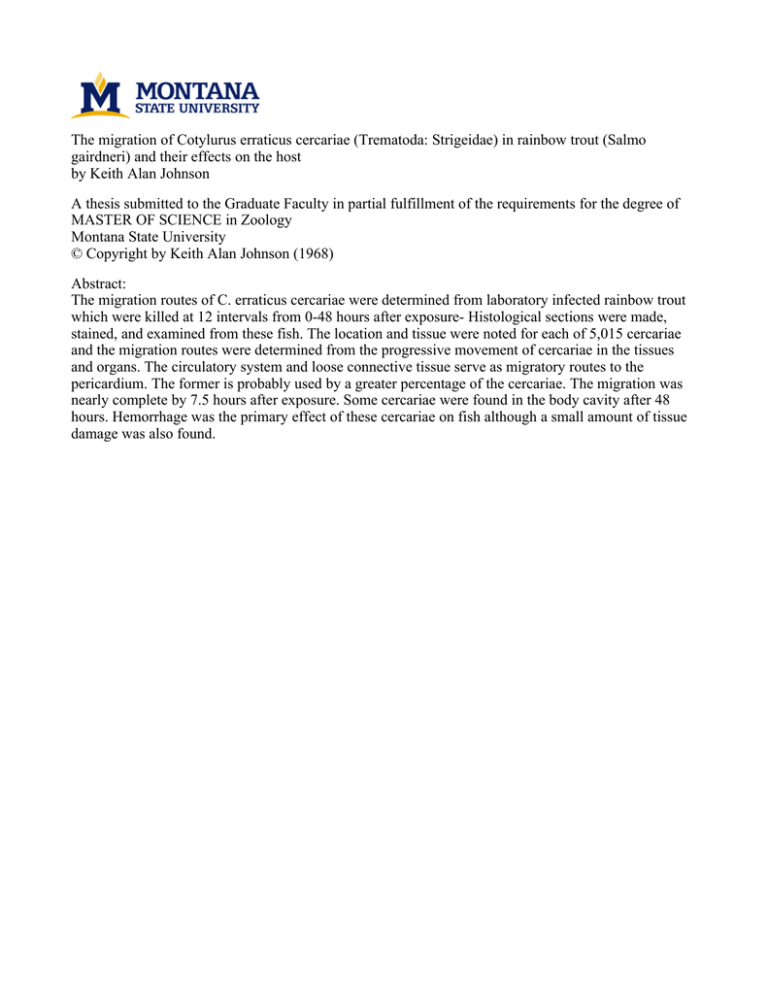
The migration of Cotylurus erraticus cercariae (Trematoda: Strigeidae) in rainbow trout (Salmo gairdneri) and their effects on the host by Keith Alan Johnson A thesis submitted to the Graduate Faculty in partial fulfillment of the requirements for the degree of MASTER OF SCIENCE in Zoology Montana State University © Copyright by Keith Alan Johnson (1968) Abstract: The migration routes of C. erraticus cercariae were determined from laboratory infected rainbow trout which were killed at 12 intervals from 0-48 hours after exposure- Histological sections were made, stained, and examined from these fish. The location and tissue were noted for each of 5,015 cercariae and the migration routes were determined from the progressive movement of cercariae in the tissues and organs. The circulatory system and loose connective tissue serve as migratory routes to the pericardium. The former is probably used by a greater percentage of the cercariae. The migration was nearly complete by 7.5 hours after exposure. Some cercariae were found in the body cavity after 48 hours. Hemorrhage was the primary effect of these cercariae on fish although a small amount of tissue damage was also found. THE MIGRATION OF COTYEURUS ERRATICUS CERCARIAE (TREMATODA: STRIGEIDAE) IN RAINBOW TROUT (SALMO GAIRDNERI) AND THEIR EFFECTS ON THE HOST by KEITH ALAN JOHNSON A thesis submitted to the Graduate Faculty in partial fulfillment of the requirements for the degree of MASTER OF SCIENCE in Zoology Approved: Chairman, Examining Committee G r a d a t e sBeanr MONTANA STATE UNIVERSITY Bozeman 3 Montana December 3 1968 ill ACKNOWLEDGMENTS I would like to express my appreciation to Dr. C. J. D. Brown for his direction of this study and providing assistance in the preparation of this manuscript. Dr. David E. Worley and Dr. John W. Jutila also gave appreciated criticism of this manuscript. Dr. Robert E. Olson provided many useful ideas and assistance in the field and laboratory portions of this study. Mr. Robert Mitchell, Anaconda State Fish Hatchery, provided facilities during field collections. Mr. Jerry Grover,.National Fish Hatchery, Ennis, Montana and Mr. Paul McAdam., Jumping Rainbow Ranch, Livingston, Montana provided fish. I wish to thank my wife, Karen, for her patience and encouragement during the progress of this study. This study was supported in part by the Montana State University Agricultural Experiment Station and the Montana Fish and Game Department. iv TABLE O F CONTENTS Page ■LIST OF T A B L E S ...............‘ . LIST OF F I G U E E S ............................................ .. ABSTRACT v vi vii INTRODUCTION I MATERIALS AND METHODS 4 RESULTS 8 . . . . . . Gross Migration . . . . . . . . . . . . . . . . . . . . . . . Cercariae in Tissues and Organs . Effects of Cercariae on Fish . . . . . . . . . . . . . . . . Metacercariae in Naturally Infected Salmonids . . . . . . . . 8 IO 20 -23 DISCUSSION . . 26 ■LITERATURE CITED . . 28 V LIST OF TABLES Table I. II. III. . PERCENTAGES OF CERCARlAE IN BODY REGIONS FOR'FOUR POST-EXPOSURE INTERVALS ....................... .. THE NUMBER AND PERCENTAGE OF CERCARIAE IN THE TISSUES AND ORGANS OF RAINBOW TROUT .......................... .. HEMATOCRIT VALUES O F R A I f f i Q l T p O U T .............. .. Page 9 11 -24 vi LIST OF FIGURES Figure 4, Page 1. Cercariae and blood 'cells in pericardial cavity......... .. 2. Cercariae penetrating from the bulbous arterosis 3.. Cercaria penetrating through the epithelium and dermal connective t i s s u e .............................. . 22 22 Cercariae entering kidneys from renal portal vein . . . . . . . . 22 22 vi i ABSTRACT The migration routes of C. erraticus cercariae were determined from laboratory infected rainbow trout which were killed at 12 intervals from 0-48 hours after exposure- Histological sections were made, stained, and examined from these fish. The location and tissue were noted for each of 5,015 cercariae and the migration routes were determined from the progres­ sive movement of cercariae in the tissues and organs. The circulatory system and loose connective tissue serve as migratory routes to the peri­ cardium. The former is probably used'by a greater percentage of the cercariae. The migration was nearly complete by 7»5 hours after exposure. Some cercariae were found in the body Cavity after 48 hours. Hemorrhage was the primary effect of these cercariae bn fish although a small amount of tissue damage was also found. INTRODUCTION The objective's of the present study were to determine the migratory route of C. erraticus cercariae in rainbow trout and the effects of cercarial migration on this fish. town Lake, near Anaconda, Montana. Field collections were'made at George­ The study extended from May, 1967 through December,.1968. Olson (1968) found the California gull, Larus caljfopnicus, was the definitive host of C. erraticus; the operculate snail, Valvata Iewisi, was the first intermediate host; and salmonid fish were the second inter­ mediate hosts. The metacercariae were found in the pericardium and a few in the body cavity of rainbow trout experimentally infected by him. .In naturally infected salmonids, he found that the pericardium was the only part infected but no detailed examination was made on the whole fish. The migration of trematode cercariae in fish has been described by several authors but only a few studies are based upon experimentation. Dubois (1929)3 using serial sections of trout infected with strigeid cercariae, found that the head region was most often penetrated. Davis (1936b) postulated that, since the migration time was short, cercariae of Diplostomum flexicaudum usually reached the eye through the blood stream. Hunter and Hunter (1940) suggested that the migration of :Posthodiplostomum minimum cercariae is through the tissues since the penetration organs of the cercariae function for a long time. Miller (1954) concluded that the blood stream was an important route of migration for P. minimum cercariae and that the liver and kidneys were infected through their portal systems. -2- Hoffman and Hundley (1957) described the location of Diplostomulum baeri .eucaliae cercariae in the different tissues of the brook stickleback and speculated that the cercariae migrated to the brain through the -circulatory system. Ferguson (1943) determined that the blood was the terminal path of D„ flexicaudum cercariae to the lens of the eye. Hoffman and Hoyme (1958) noted that D. baeri eucaliae cercariae usually penetrated the head region, migrated through the tissues, and at least some entered the blood stream to reach the brain. Hoffman (1958) studied P. minimum in the fathead minnow and found that some cercariae reached the kidneys in less than four hours through the renal portal system. Erasmus (1959) stated that Cercafia X (Baylis) usually penetrated the head region and migrated through the connective tissues and muscle, although a few were in the blood stream at a n y :giten'; time. Sublethal effects on the tissues and organs of fish have been re­ ported by several authors. The cellular reaction of fingerling largemouth bass to encysting Uvulifer -ambloplitis cercariae was discussed by Hunter and Hamilton (1940). Hoffman (1956, 1958) noted hyperemia and congested blood vessels in fathead minnows in response to Crassiphiala bulboglossa and P. minimum cercariae. Hemmorhage due to migrating D. baeri eucaliae cercariae has been reported around the eyes and brain of brook stickle­ backs (Hoffman and Hundley, 1957? Hofflnan and Hoyne, 1958). Hemmorhage and muscle necrosis from Heogogatea kentuckiensis cercariae in trout was reported by Hoffman and Dunbar (1963). Lethal effects of cercariae on -3“ fish have been described by Krull (.1934), Dawes (1952), Hoffman (1956), Hoffman and Hundley (1957)j and others. MATERIALS AID METHODS CercarIae of erraticus were harvested from laboratory infected .Vo lewis! which were collected from Georgetown Lake. The miracidia used to infect these snails were hatched from eggs collected from laboratory infected California gulls. The rainbow trout was used exclusively because it is a suitable host and was available in the sizes desired. Most of the trout used came from the National Fish Hatchery, Ennis, Montana (Nov., 1967), but a few were from the Jumping Rainbow Ranch, Livingston, Montana (Aug.-Sept., 1968). All fish were maintained in laboratory hatchery troughs with running water (12 C) until needed. Infected snails were placed in Stender dishes containing tap water drawn several days in advance. Once each day the water containing cer- cariae was transferred to either a.beaker or a small aquarium containing the experimental fish and additional water was then added to the Stender dishes. The number of eercariae used for infection experiments was deter­ mined from samples of the total volume. for 0.5 hours. 240-530 ml). All fish were exposed to eercariae The average volume of water per fish was 3&5 ml (range: The water temperature during exposure averaged 20.7 C (range: 19-5-21.7 C ) . Fish were transferred to other containers and the number of eercariae remaining after exposure was determined as above. The difference between the number of eercariae before and after the in­ fection was assumed to be the number which entered the fish. Success of cercarial penetration was expressed as the percentage of the eercariae -5- which penetrated. This averaged 73.6$. The temperature at which fish were held after exposure averaged 20.0 C (range: 18.8-22.8 C). The post­ exposure interval includes the time from the end of exposure until fish were killed. (hours): 48.0. One fish was used for each of the following Intervals 0.0, 0 .5, 1 .0 ,.1 .5, 2 .5, 3 .5, 5 .5, 7 .5, 11.5, 18.0 , 24.0, and Fish were killed and fixed with Bouin1s solution, washed in 70$ ethanol, decalcified in 3$ HCl, dehydrated in absolute ethanol, cleared in toluene, and embedded in paraffin. Transverse sections of the entire fish were made at 12 JJ, Except for the region of the pericardium, every fifth section was mounted. were used. If fifth sections were mutilated, the fourth or sixth sections All sections 'in the region of the pericardium were mounted. Sections were stained with Delafield's hematoxylin and eosin Y. In general, every fifth section of the whole fish was examined for cercariae. The cercariae found in the sections were placed in tissue categories similar to those of Erasmus (1959)- The slide number, section designation, occurrence, orientation, and presence of hemorrhage were recorded for each. In order to determine the gross migration of cercariae, fish were divided into the following body regions: head (tip of snout to first gill arch); pectoral (first gill arch to posterior base of pectoral fin); abdom­ inal (pectoral fin to anterior base of pelvic fin); pelvic (pelvic fin to .posterior margin of anus); caudal (anus to end of caudal fin). The total number of cercariae in all regions was determined for each fish. To aid in analyzing the migration of cercariae in the tissues and organs, the -6- fish were divided into consecutive .600J J units. sections,.10 of which were examined. aged 68.8 (range; 44-78). Each unit contained 50 The number of units per fish aver­ The number and percentage of cercariae were determined for each tissue category of each unit and of the whole fish. The humber and percentage of cercariae was determined for each unit. The number of cercariae found in a fish was always much less than the number calculated. This was probably due to error in the determination of in­ fection levels. Hematocrit values were used to evaluate the sublethal effects of cercariae on fish. Rainbow trout used in these experiments were obtained from the National Fish Hatchery,.Ennis3 Montana (March, 1968). The tech­ nique used for infecting fish was similar to that described above but the average temperature was 21.6 C (range: 19.4-23.3 C) and the average volume per fish was 813*6 ml (range: 775-850 ml). The number of cercariae which entered the fish during exposure was determined as described above. Eive fish were removed from an aquarium daily, blood samples were taken from one of these (first control), centrifuged, and read while two experimental fish were being exposed to cercariae (0.5 hours). After exposure, the infected fish were transferred to another container and held (average water temperature: 20.8 C; range: 18.9-21.7 C). One fish-was removed 2.5 hours after -exposure and hematocrits were determined for it and a second control fish. Hematocrits-were taken on the, last infected fish and the third control fish four hours after exposure, = Two blood samples were secured from the caudal artery and put in heparinized capillary tubes -J- from all five fish each day and centrifuged at 123500 r.p.m. in an Adams Micro-hematocrit Centrifuge for five minutes. Hematocrit values were determined with an Adams Micro-hematocrit Reader and the values for each fish were averaged. An effort was made to find C. erraticus metacereariae in areas other than the pericardium of naturally infected fish. Several fish collections were made in Georgetown Lake by gill netting and angling for this purpose. The fish collected included 25 rainbow trout 3 four brook trout 3 Salvelinus fontinalis, and three kokanee salmon,.Onchorhynchus nerka. EESULTS The migration of C. erraticus cercariae is considered in relation to time as follows: the gross migration of cercariae in fish, the change (percentage) in total numbers of cercariae for the tissues and organs, and the distribution of cercariae in certain selected tissues and organs. Gross Migration The migration of cercariae in the fish is illustrated by progressive changes.in the percentage of cercariae in the different body regions. The percentage of cercariae in these regions was determined for each of the 12 post-exposure intervals, but only the 0 .0 , 5 .5, 11.5, and 48.0 hr ■intervals were used because they show all important successive changes. All times given in the text refer to the post-exposure intervals. The percentage of cercariae in the different regions changed with ■increased time (Table I ). Penetration usually occurred at the bases of the fins and opercula, along the lateral line, near the margins of the scale platelets, and other places where the epithelium was irregular. At 0=0 hr, most of the cercariae were close to the external surface regardless of the region penetrated. trated by cercariae. The pectoral region was most frequently pene­ This agrees with the findings of Hoffman and Hoyme (1958) and Erasmus (1959) • The head region of their studies includes the pectoral region as defined by me. The majority of the cercariae found in the pectoral region were in the gills, opercula, and dorsal pharynx. -i9- TABLE I. PERCENTAGES OF CERCARIAE IR BODY REGIONS FOR ■FOUR'POST-EXPOSURE INTERVALS ______ ___________ Post-exposure interval (hours) 0.0 5°5 11.5 48.0 Body Region-_____________________ Head_____ Pectoral_____ Abdominal_____ Pelvic_____ Caudal n.9 3.6 0.7 0.8 51.3 74.8 79.0 83.4 22.1 8.2 17.0 i4.6 7.6 7.1 11.3 2.1 0.0 0.0 . 3.3 1.2 -10- The percentage of cercariae in the pectoral region increased with time 3 while the percentages in the other regions decreased. The rate of decrease was less in the abdominal region than, in the other three regions. After -48.0 hr 3 $ 8% -of the cercariae was found in the pectoral and abdominal regions. Most of the cercariae in the pectoral region localized in the ■pericardium but some were retained in the body cavity of the abdominal region. In general 3 there was a reduction of cercariae in the other body regions as the percentage increased in the pericardium. The change in distribution of cercariae with increased intervals indicates that migra­ tion to the pericardium is progressive and not random. Non-random migration of trematode cercariae in fish was reported by Ferguson (1943) and Erasmus■(1959)° It can also be inferred from the results of Miller (1954)3 Hoffman and Hundley (1957)s Hofflnan and Hoyme (1958)3 and Hoffman (1958). Cercariae in Tissues and Organs All 12 post-exposure intervals are used to 'Show the changes in the percentage of cercariae in the tissues and organs. The percentage of cercariae in the tissues 'and organs decreased as time increased,.except for the pericardium and body cavity (Table I I ). Some tissues and organs had cercariae for much longer periods than others. A few organs rarely contained cercariae and these may have been abnormal locations. The cercariae considered to be in abnormal locations were found in fish with TABLE II. THE NUMBER AND PERCENTAGE OF CERCARIAE H Interval ______________________________________Tissues and Organs Kid. Ht. B.V. P.C. B.C. S.M. Gil. Epi . C.t. (hours) 0 .0 no. i 0 .5 no. t 1 .0 no. Io 1.5 no. i 2.5 no. i 3.5 no. % 5-5 no. i 7.5 no. i 11.5 no. i 18.0 no. Io 24.0 no. Io 48.0 no. i 36 H .7 THE TISSUES AND ORGANS OF RAINBOW TROUT Liv. N.S. Fins Oth. 307 109 169 55-1 12 3 .9 79 25.7 58 53-2 25 23.0 7 6 .4 4 3-7 6 5.5 4 3.7 2 1.8 I I I 0 .9 0 .9 0 .9 275 36.6 126 16.8 93 12.4 4o 5-3 15 2 .0 144 19.1 24 3.2 5 0 .7 3 0 .4 15 2.0 37 30.8 17 14.2 11 9.1 5 4.2 2 1 .7 45 37.5 3 2 .5 402 37.9 176 15.7 135 12.1 52 5-6 23 2 .1 198 17.7 74 6 .6 13 1.2 10 0 .9 7 0 .6 6 0.5 0.1 157 23.9 24 3 .7 139 20.2 11 1.8 5 0.8 230 35.0 34 5.3 25 3 .9 5 0.8 25 3-9 3 0.5 0.2 199 33.6 21 3-5 25 4.2 23 3-9 31 5-2 229 38.6 25 4.2 23 3 .9 3 0.5 3 0.5 11 1.9 37 13.2 I 2 .8 0 .3 2 0 .7 175 61.8 7 2 .5 50 17.7 1.0 13 4.3 4 1.3 7 2 .3 5 1 .7 201 66.8 12 4.0 52 17.3 7 2 .3 11 6 .1 9 4 .9 I 0 .6 9 5.0 127 73.0 3 1.7 18 10.1 20 5.3 2 0 .5 2 0.5 2 0.5 299 78.3 15 3 .9 4i 10.7 0 .3 13 5.6 I 2 0 .8 172 74.1 I 0 .4 0 .4 39 16.7 5 2 .0 8 11 1.5 Total 11 3-6 I 752 0.1 120 3 I 1097" 659 593 283 301 I 0.6 I I 179 382 233 Abbreviations: Epi.- Epithelium; C.t.- Connective tissues; S.M.- Skeletal Muscle; Gil.- Gills; Ht.- Heart; B.V.- Blood Vessels; P.C.- Pericardium; Kid.- Kidneys; B.C.- Body Cavity; Liv.- Liver; N.S.- Nervous System; Oth.- Other Locations. -12- the greatest- number. Those found in any given organ were not included in the total for the tissue category, this system. Cercariae were counted only once by Each tissue and organ which contained cercariae is treated separately and the percentages are considered in relation to migration. The distribution of cercariae in successive 600 tained for each tissue and organ for 'all intervals. JJ fish units was ob­ The distributions in connective tissues <> circulatory system, and body cavity show a progressive movement of cercariae toward the pericardium with increased time. This progression shows that these tissues may serve as migration routes for cercariae. Epithelium. The epithelium contained about 12$ of the total cer­ cariae found in the fish at 0.0 hr interval. At this time, they were distributed over the surface of the entire fish with concentrations in the head and pectoral regions. intervals. None were found in the -epithelium at other The distribution in the epithelium was about the same as the distribution for the entire fish. Since most cercariae penetrated perpen­ dicular to the external surface, and only 12$ were found ,in the epithelium soon after exposure ended, cercariae must not migrate any appreciable dis­ tance within the epithelium, but rather into the internal tissues and organs. Connective Tissues. Cercariae were found in the connective tissues at all intervals -but the percentage decreased with increased time. following' .connective tissues' were recognized: cavities. The dermal, dense, loose, and The dermal connective tissues, located just below the epithelium, -13- contained 43% of all cercariae at 0.0 hr, but this decreased to 1% at 7*5 hr. This decrease resulted from cercariae passing through these layers into the muscle or other tissues.. The dense connective tissue contained very few cercariae. The loose connective tissues and cavities contained most of the cercariae found in the connective tissues at intervals after 0.5 hr. The percentage of cercariae in all connective tissues decreased from 55 at 0.0 hr to 13 at 7•5 hr and to 6 at 48.0 hr. While these connective tissues contained cercariae at all intervals, most migrated out by 7-5 hr. By this time, cercariae in the pericardium increased to 62%. The loose connective tissue near the pericardium contained a concentration of cer­ cariae between 1.0 and 7°5 hr, and several penetrated from this adjacent tissue into the pericardium. The distribution of cercariae in the fish units shows that those in the connective tissues migrated toward the pericardium with increased time. Most cercariae in the connective tissues at 0.0 hr were found between the posterior margin of the eyes and the posterior base of the pectoral fin. The others in- this tissue were scattered in all units from the tip of the snout to the base of the caudal fin. After 2.5 hr cercariae began to concentrate toward the pericardium and at 3=5 and 5=5 hr the concentration there was still higher. Between 5=5 and 7=5 hr there was a large decrease in the percentage of cercariae in the connective tissues, while at the same time, there was a marked increase in the cercariae in the pericardium. This may result from movement from the connective tissues into the -14- peri eardrum. This progressive change in position., toward the pericardium shows that the connective tissue is used as a migratory route to the peri­ cardium. Further evidence that connective tissues serve this purpose is shown by cercariae entering the pericardium from the adjacent connective tissues and by the hemorrhage found around the pericardium. The pericardium was filled with blood which was released when cercariae entered from the circulatory system. As cercariae entered the pericardium from the con­ nective tissue, they disrupted this connective tissue. The blood seeped from the pericardium and spread in all directions which indicated that cercariae entered through these tissues. Further evidence of the connec­ tive tissue route was seen in the fish at 0.5 hr when a few cercariae were found in the pericardium. These must have come from the connective tissues since no blood cells were found in the pericardium. Skeletal Muscle. The percentage of cercariae in the skeletal muscle increased from 4 at 0.0 hr to 23 at 0.5 hr, decreased to 4 at 3-5 hr and to 0.4 at 48.0 hr. The increase seen between the first two intervals re­ sulted from cercariae entering the muscle from the dermal connective tissue and the decrease from 0.5 to 48.0 hr resulted from cercariae leaving the muscle enroute to the pericardium or body cavity. The distribution of cercariae in the muscle did not show progressive movement toward the pericardium with increased time and is evidence that the skeletal muscle was not a route of migration. Cercariae were found entering blood vessels within the muscles and presumably some reach the I -15- pericardium. through this route. Several cercariae were found entering the body cavity from the hypaxial muscles of the side and this may be how most of them enter the body cavity. Gills. About 25$ of all cercariae at 0.0 hr were found in the blood vessels, loose connective tissue, cavities, and epithelium of the gills. The blood vessels contained slightly more cercariae than the loose con­ nective tissue or cavities. " Those found in the blood vessels were in the afferent arterioles and capillaries. Those in the loose connective tissue and cavities were usually near these blood vessels. Hemorrhagic areas were frequently found near the blood vessels of the gills and numbers were highest in those fish which contained the greatest total number of cer­ cariae. The epithelium of the gills contained cercariae at only 0.0 and 0.5 hr. Cercariae found in the gills decreased from 26$ at 0.0 hr to about V1 J0 after 5•5 hr. The migration of cercariae from the gills to the pericardium is by way of the circulatory system and connective tissues. Circulatory System. Cercariae in the heart, and blood vessels increased from QaJ0 at 0.0 hr to 9% at 0.5 hr and decreased to 2$ at 11.5 hr. found in the circulatory system' at 48.0 hr. None were The heart proper contained cer­ cariae from 0.5 to 24.0 hr and blood vessels between 0.5 and 5-5 hr. Cercariae in the arteries were primarily in the ventral aorta and afferent arterioles.leading to the gills. Cercariae were not found in other arteries of the body except a few near the brain. Only 30 cercariae were found in the ventral aorta and afferent arterioles between 1.0 and -i6- 5-5 hr compared to 220 in the gill blood vessels. Some were able to mi­ grate toward the heart against the flow of blood in the afferent arterioles and ventral aorta, but most penetrated from the blood vessels of the gills and migrated to the pericardium through the loose connective tissue near the afferent arterioles and ventral aorta since a considerable number were found in the loose connective tissue near these vessels. Ferguson (19^3) noted that D. flexicaudum cercariae penetrated the blood vessels of the caudal fin and moved against the flow of blood but were swept with it whenever they lost their hold on the vessel wall. Between the 0..5 and 5-5 hr intervals, most cercariae in the circula­ tory system were in the caudal vein, renal portal vein, the blood vessels of the kidneys, and the duct of Cuvier which enters the sinus venosus of the heart. These veins form a continuous circulatory route from the caudal region to the heart. Many cercariae were found along this route and this may account for the early decrease in the caudel region (Table l). A few were found in the venous circulation of the head region and presumably these reach the heart by the veins. Many cercariae were found within the chambers of the heart and ventral aorta. Penetration from here apparently occurred in the areas where the walls were wrinkled. Wrinkling probably causes eddies to form and this would allow cercariae to attach and penetrate through the wall. about 30 JJ in diameter remained after cercariae penetrated. Holes Blood flowed through these holes into the pericardium, often completely filling it. These penetration holes were more frequent in the ventral aorta than in -17- the ventricle or atrium, and a limited amount of tissue necrosis was pre­ sent near the holes. A greater percentage of cercariae probably used the circulatory route for migration because the percentages in the heart were usually about, twice that in the loose connective tissues near the pericardium. Pericardium. The percentage of cercariae in the pericardium in­ creased from 0 at 0.0 hr to 62 at 7«5 hr. from 7-5 to 48.0 hr at which time pericardium. The rate of increase was slower rJ h0I0 of the cercariae were found in the Most cercariae reach the pericardium in a short time. Ferguson (1943) and Erasmus (1959) reported that D. flexicaudum and Cercaria X respectively, reached .their, final destination in about'. 24 hours.Hoffman and Hoyme (1958) found that cercariae of D. baeri eucaliae reached the brain in about 28 hours, but migration to the choroid plexus was not completed before 60 days. The cercariae in the pericardium at 48.0 hr were not encysted and were free to move within it. There was no indication of any host con­ nective tissue proliferation which might wall-off these cercariae. Olson (1968) reported that C. erraticus cercariae encyst between the second and third week after exposure. Kidneys. Cercariae in the kidneys increased from 2% at 0.5 hr to J0Io at 2.5 hr and decreased to 0.4% at 48.0 hr. The kidneys retained cercariae for a longer time than most other organs. kidneys was through the renal portal vein. The infection of the The cercariae in the kidneys ■probably came from the caudal region,.entered the venous circulation, and -18- were transported to the kidneys. Most cercariae in the kidneys were in the blood vessels of the posterior part. This may have resulted from the renal portal vein branching into a capillary network there.- This capil­ lary network may have impeded the migration of cercariae, resulting in an accumulation. Body Cavity. hr. Cercariae were rare in the body cavity from 0.0 to 1.5 The percentage increased from I at 2.5 hr to 18 at 7*5 hr and after 7.5 hr, the percentages remained between 10 and 17. Most cercariae which entered the body cavity probably came from the hypaxial muscles of the body wall since several were seen entering from these muscles. Blood cells were frequently found in the body cavity after 5-5 hr and may have resulted from a few cercariae entering the liver from the body cavity. The distribution of cercariae in the body cavity showed that pene­ tration occurred along its entire length but apparently cercariae migrated toward the anterior end with increased time. By 18.0, 24.0, and 48.0 hr, most of the cercariae were in the anterior end of the body cavity near the pyloric caecae and pancreas. Some of these probably encyst and remain in the body cavity, since Olson (1968) found C_. erraticus metacercariae near the pyloric caecae of experimentally infected rainbow trout. Liver. 12 intervals. A few cercariae were found in the liver during most of the The majority were in the liver sinusoids. served penetrating into the liver from the body cavity. Three were ob­ This may account for some of the -hemorrhage in the body cavity, and may be a route for cer­ cariae to reach the heart from the body cavity since the hepatic veins -19- connect directly to the sinus venosus of the heart. No cercariae were found in the hepatic portal vein or the arterial circulation to the liver. Miller (1954) reported that P. minimum cercariae penetrated from the liver into the body cavity to encyst on the mesenteries and surfaces of other organs. Apparently the reverse is true for CL erraticus cercariae. The cercariae in the liver were usually less than 2.% of the total and there was no observable pattern with increased time. Nervous System. Occasionally cercariae were found in the brain, op­ tic nerves, and eyes. These organs are considered abnormal locations for cercariae because so few were found. All but one of these cercariae were found in four fish which had the greatest number of cercariae. Those found in the brain were usually in the tissues or ventricles of the optic lobes. Ferguson (1943) and Hoffman and Hoyme (1958) found that of the cercariae in the nervous system, most were in the optic lobes or vent­ ricles. A few were in the chambers of the eyes and under the epineurium of the optic nerves. This may be a pathway from the eyes to the brain. Some hemorrhage was found in the ventricles at 2.5 and 3*5 hr, and the cells in the immediate.vicinity of the cercariae in the optic lobes were compressed. It is doubtful if this damage would have caused the death of these fish. Fins. The percentage of cercariae in the fins was highest at 0.0 hr and decreased until no cercariae were found after 5•5 hr. were not a major site of penetration. The fins Most of the fins had been pene­ trated in about equal numbers except the adipose fin where only two were -20- found. The bases.of the fins usually contained a large number of pene­ trating cercariae, but these were included under the epithelium. Other Locations. Three cercariae were found which did not belong in any of the above categories. One was in the smooth muscle of the esopha­ gus, another in the smooth muscle of a pyloric caecum, and the third under the serosa of the esophagus. tions. These were considered to-be abnormal Ioca-. Each of these cercariae was found in one of the most intensely infected fish at 1.0, 2.5, and 3-5 hr. Effects of Cercariae on Fish Reaction of fish to cercariae. The reactions of rainbow trout to C. erraticus cercariae were recorded during and. after exposure. These re­ actions depended upon the number of cercariae and the size of the fish. Exposures to 300-700 cercariae usually resulted in erratic swimming and darkening along the margins of the abdomen. Exposures to 700-1100 fre­ quently resulted in erratic swimming, darkened body color, partial loss of equilibrium, and hemorrhage. The partial loss of equilibrium usually occurred during or shortly after exposure and lasted for up to five hours. Hemorrhagic areas appeared 1.0 hr after exposure and were confined to the bases of the fins and isthmus.- Exposures to 1240, 1300, and 2000 cer­ cariae were lethal to fish about 50 mm in total length, while 200-500 were lethal to those 25 mm in length. Prior to death, these fish exhib­ ited erratic -swimming, darkened body color, loss of equilibrium, and hemorrhagic areas. Similar results were reported by KrUll (1934 ), Davis -21- (1936b), Hoffman (1956), Hoffman and Himdley (1957), Hoffman (1958), Erasmus (1959), Hoffman and Dunbar (1963)5 and others, Effects of Cercariae on Tissues and Organs. resulted from migrating cercariae. Hemorrhage frequently Large hemorrhagic areas were in the loose connective tissues around the afferent arterioles of the gills, in the pericardium, the body cavity, and at the bases of the dorsal, pelvic, and anal fins. Small hemorrhagic spots were found in skeletal muscle. Hemorrhage was extensive in the gills and pericardium in lethal infec­ tions and may have been the cause of death. Hoffman and Hoyme (1958) attributed the death of sticklebacks to hemorrhage resulting from D. baeri eucaliae infections. Another effect on fish occurred when cercariae entered the capil­ laries of the gills. The cercarial body was about the same diameter as the capillary and blocked the passage of blood cells. This occurred fre­ quently in heavy infections and may have interfered with respiration. Most tissues showed no damage from cercariae because the latter generally migrated in spaces between bundles of cells rather than through them. In the case of skeletal muscle, cercariae were almost always found between the bundles of muscle fibers. Erasmus (1959) reported that Cer- caria X penetrated through the muscle of the three-spined stickleback (Gasterosteus aculeatus) leaving a path of destroyed cells. Some tissue necrosis and leucocytes were found around the penetration holes in the walls of the ventral aorta (Fig. l) and heart (Fig. 2). Cells of these necrosed areas were fragmented and darker than other cells. This -22- Fig. I. Cercariae and blood cells in pericardial cavity. Two cercariae (A) in lumen of ventral aorta. Penetration hole and necrosis in the ventral aorta (B). HScE, 200 X. Fig. 2. Cercariae penetrating from the bulbous arterosis. H&E, 425 X. Fig. 3. Cercaria penetrating through the epithelium and dermal connective tissue. HScE5 800 X. Fig. 4. Cercaria entering kidneys from renal portal vein. HSeE5 250 X. -23- cellular response was probably initiated by necrosed tissue and not by cercariae since it occurred only with necrosis. The optic lobe of the ■brain did not show any tissue damage other than cell compaction in the immediate vicinity of a cercaria. might be expected. No penetration paths were found as Hemorrhage in the ventricles of the brain may have had some effect on the loss of equilibrium. Cells around cercariae in the epithelium were compacted but not necrosed (Fig. 3)• The major effect of £. erraticus cercariae on rainbow trout appears to result from hemorrhage 3 and the amount of hemorrhage increased as the number of cercariae increased. Hematocrit. Rainbow trout used in these experiments averaged 88.2 mm total length (range: 64-111 mm), while the average number of cercariae per fish was 775 (range: 730-880).. Using the completely randomized design of analysis of variance, there were no -significant differences between the means of all groups at the 95$ level (Table III). This verifies the re­ sults of Olson (1968) who made hematocrit determinations on rainbow trout infected with Ch erraticus. Smitherman (1964) and Fox (1966) showed significant depression of hematocrit values of fish due to cercariae. Metacercariae in Naturally Infected Salmonids . Twenty-five rainbow trout, four brook trout,, and three kokanee salmon from Georgetown Lake were examined for metacercariae in the peri­ cardium, body cavity, and kidneys. in the pericardium. All fish had numerous metacercariae Eleven rainbow trout had metacercariae in the body -2k- TABLE III. HEMATOCRIT VALUES OF RAINBOW TROUT Group No. Observations Post-exposure Interval (hours) Hematocrit Mean Control 10 0.0 30.3 Control 10 2.5 30.2 Control 11 4.0 29.4 Infected 10 2.5 29.5 Infected 11 4.0 28.6 i -25- cavity but none in the kidneys. One brook trout had them in the body cavity while two had metacercariae in the kidneys. the body cavity or kidneys of kokanee salmon. None were found in Although the sample is small, it does show that metacercariae encyst in areas other than the pericardium. Olson (1968) found _C. erraticus metacercariae encysted in the body cavity of rainbow trout infected in the laboratory but did not find them in the body cavity of naturally infected salmonids. DISCUSSION Most of the effects of C= erraticus cercariae on rainbow trout are probably due to hemorrhage released as cercariae entered and left the circulatory system. It is doubtful if C. erraticus infections are lethal to rainbow trout fingerlings in Georgetown Lake, since Olson (1968) found that rainbow trout 186 mm in length accumulated about 100 metacercariae during the summer and about twice that number were required to kill a fish 25 mm in length exposed for 0=5 hr. .The cells adjacent to cercariae in the epithelium, brain, and ventral aorta were usually compressed but not lysed. This suggests that the secre­ tions of the cercarial penetration organs probably contain hyaluronidase, the spreading agent found in Schistosoma mansoni cercaria by Levine, .et ad. (1948). Hyaluronidase depolymerizes the hyaluronic acid of the inter­ cellular bridges and this would'result in cells being pushed aside by the cercariae rather than being lysed. The secretions may also be lubricative (Kruidenier, 1951; Erasmus, 1959)3 which would aid their movement through tissues. Davis (1936a) proposed the lytic function and this has been supported by Davis (1936b ) , Lewert and Lee.(1954), and Hoffman (1958). The nature of these secretions should be investigated further. The stimulus which attracts cercariae to the pericardium was not studied but the results suggest that it may be physical rather than chemi­ cal. Since cercariae migrated in the circulatory system and connective tissues, the stimulus must function in both routes. heartbeat. The stimulus may be This could be tested by placing a pulsating device in another. -27- area of the body and see if cercariae are attracted to it. Davis (1936b) was unable to demonstrate any preference of cercariae to different tissues in vitro. Ferguson (19^3) found that transplanted eye lenses did not attract cercariae and light did not affect the migration. LITERATURE CITED Davis, D. L. .1936a. Report on the preparation of an histolytic ferment present in the bodies of cercariae. J. Parasit. 22: 108-110. ___________ . .1936b. Pathological studies on the penetration of the cercaria of the strigeid trematode, Diplostomum flexicaudum. J. Parasit. 22: 329-337Dawes,' B,. 1952. Trematode life-cycle enacted in a London pond. London. 170: 72-73. Dubois, G. 1929. Les cercaires de la region de Neuchatel. neuchatel. Sci. nat. 53: 3-177- Nature, Bull. Soc. Erasmus, D. A. .1959- The migration of Cercaria X Baylis (Strigeida) within the fish intermediate host. Parasitology. 49: 173-190. Ferguson, M. S. 1943. Migration and localization of an animal parasite within the host. J. Exp. Zoology. 93: 375-401. Fox,.A, C. 1965. The life cycle of Bulbophorus confusus (Krause, 1914) Dubois, 1935 (Trematoda.: Strigeoidea) and the effects of the metacercariae on fish hosts. Ph.D. thesis, Montana State University, Bozeman, Mont., 49 p. Hoffman, G- L. 1956. The life cycle of Grassiphiala bulboglossa (Trematoda: Strigeida). Development of the metacercaria and cyst, and effect on the fish hosts. J. Parasit. 42: 435-444. _____________ . 1958. Experimental studies on the cercaria and meta­ cercaria of a strigeoid trematode, Posthodiplostomum minimum. Exp. Parasit. rJ-. 23-50. _____________ ., and J. B. Hundley. 1957- The life-cycle of Diplostomum baeri eucaliae n. subsp. (Trematoda: Strigeida). J. Parasit. 43: 613-627. ________ ., and J. B. Hoyme. 1958. The experimental histopathology of the "tumor" on the brain of the stickleback caused by Diplostomum baeri eucaliae (Hoffman and Hundley, 1957) (Trematoda: Strigeida). J. Parasit. 44: 374-378. ________ ., and C. E. Dunbar. 1963. Studies on Neogogatea kentuckiensis (Cable, 1935) n. comb. (Trematoda: Strigeoidae: Cyathocotylidae) J. Parasit. 49: 737-744. -29- Hunter, G. W , , and W. S. Hunter. 1940. Studies on the development of the metacercaria and the nature of the cyst of Posthodiplostomum minimum (MacCallum, 1921) (Trematoda; Strigeata")! Trans. Amer. Micr. Soc. 59: 52-63. __________ __., and J. M. Hamilton. 1941. Studies on host-parasite re­ actions to larval parasites. IV. The cyst of Uvulifer ambloplitis (Hughes). Trans. Amer. Micr. Soc. 60: 498- 507. Kruidenier, F. J. 1951- Studies in the use of mucoids by Glinostomum marginatum. J. Parasit. 37 (Suppl. 2): 25-26. Krull, W. H. 1934. Cercaria bessiae Cort and Brooks, 1928, an injurious parasite of fish. Copeia 1934: 69-73° Levine, M. D . , R. F. Garzoli, E. E. Kuntz, and J= H. Killough= 1948. On the demonstration of hyaluronidase in cercariae of Schistosoma mansoni. J. Parasit. 34: 158-161. Lewert, E. M., and C. Lee. 1954. larvae through host tissues. Studies on the passage of helminth J. Infect. Dis. 95: 13-51. Miller, J. H. 1954. Studies on the life history of Posthodiplostomum minimum (MacCallum, 1921). J. Parasit= 40: 255-270. Olson, R. E. 1968. The life cycle of Cotylurus erraticus (Rudolphi, 1809) Szidat, 1928 (Trematoda: Strigeidae) and the effect of the metacercaria on rainbow trout (Salmo gairdneri). Ph.D. thesis, Montana State University, Bozeman, Montana. 42 p. Smitherman, Jr., R. 0. .1964= Effects of infections with the strigeid trematode Posthodiplostomum minimum (MacCallum), upon the bluegill, Lepomis macrochirus Rafinesque-. Ph.D. thesis, Auburn Univ. 68 p. Univ. Microfilms. Ann Arbor, Mich. (Diss. Abstr. 25: 2115.) MONTANA __ !_ 3 1762 10014588 5 k N 378 J o hnson, J6344 cop.2 The m i g r a t i o n of C o t y l u r u s erraticus K. A. c e r c a r i a e (T r e m a t o d a : S t r i g e i d a e ) in r a i n b o w . ., IMAMg A N P / A P D P g a B TT J^u-y3 N BkIS Co ^ ^ /
